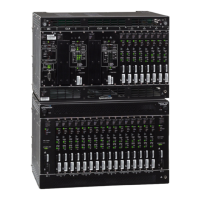097-55501-01 Revision M – January 2009 TimeHub 5500 User’s Guide 39
Chapter 1 Description
Master/Remote Shelf
Two CC outputs are taken from a Master shelf connected as CC inputs to the
Remote shelf. Two outputs are used for redundancy; to isolate the signal paths
as much as possible, you can take each CC signal from a different output group
on the Master shelf (for example, one from the “C” group and another from the
“D” group). You compensate for the delay due to the cable length from the Master
shelf using the CCDEL and CCDENB keywords. The preferred method is to
compensate for the delay at the Master shelf.
Two ESF-framed DS1 outputs from different output groups on the Master shelf
are connected to the first two DS1 inputs on the Remote shelf. This provides a
redundant method for the remote shelf to receive SSM information from the
Master shelf.
Operational Specifics
This section describes the capabilities of the Remote shelf that are not available on a
Master shelf. The TimeHub 5500 Clock cards are designed to operate in either a
Master or Remote shelf configuration. When configured for Remote operation, the
Input LEDs on the front panel of the Clock card display information for the inputs. See
Figure 2-2
, which shows the front panel of the Clock card. The relevant LEDs are CC
1 and 2 and DS1 1 and 2.
CC Timing Inputs
Timing references for the Remote shelf are connected at the Input/Alarm Connector
module, located on the rear panel of the shelf (refer to Figure 3-18). This module
supports both Master and Remote operation. For Remote operation, the available
timing inputs are labeled CC IN 1 and CC IN 2. Typically a TimeHub 5500 or DCD
master shelf provides these signals.
DS1 SSM Inputs
Composite Clock input signals do not provide SSM information that can be included
on Remote output signals. You can connect ESF-framed DS1 inputs to a Remote
shelf in order to receive encoded SSM information from the Master shelf. The
Remote shelf then passes the SSM information on to the outputs. The sole function
of these DS1 inputs is for SSM decoding; they are not used as timing references.
SSMs in a Remote Shelf
Table 1-2 describes how the source of SSM is determined in a Remote shelf for a
variety of conditions. Other than the special case where the OMANSSM keyword is
used to manually set the output SSM value (see TimeHub 5500 TL1 Reference
Guide for details), the SSM source determines the SSM that is encoded on each
ESF-framed DS1 output generated on the Remote shelf.

